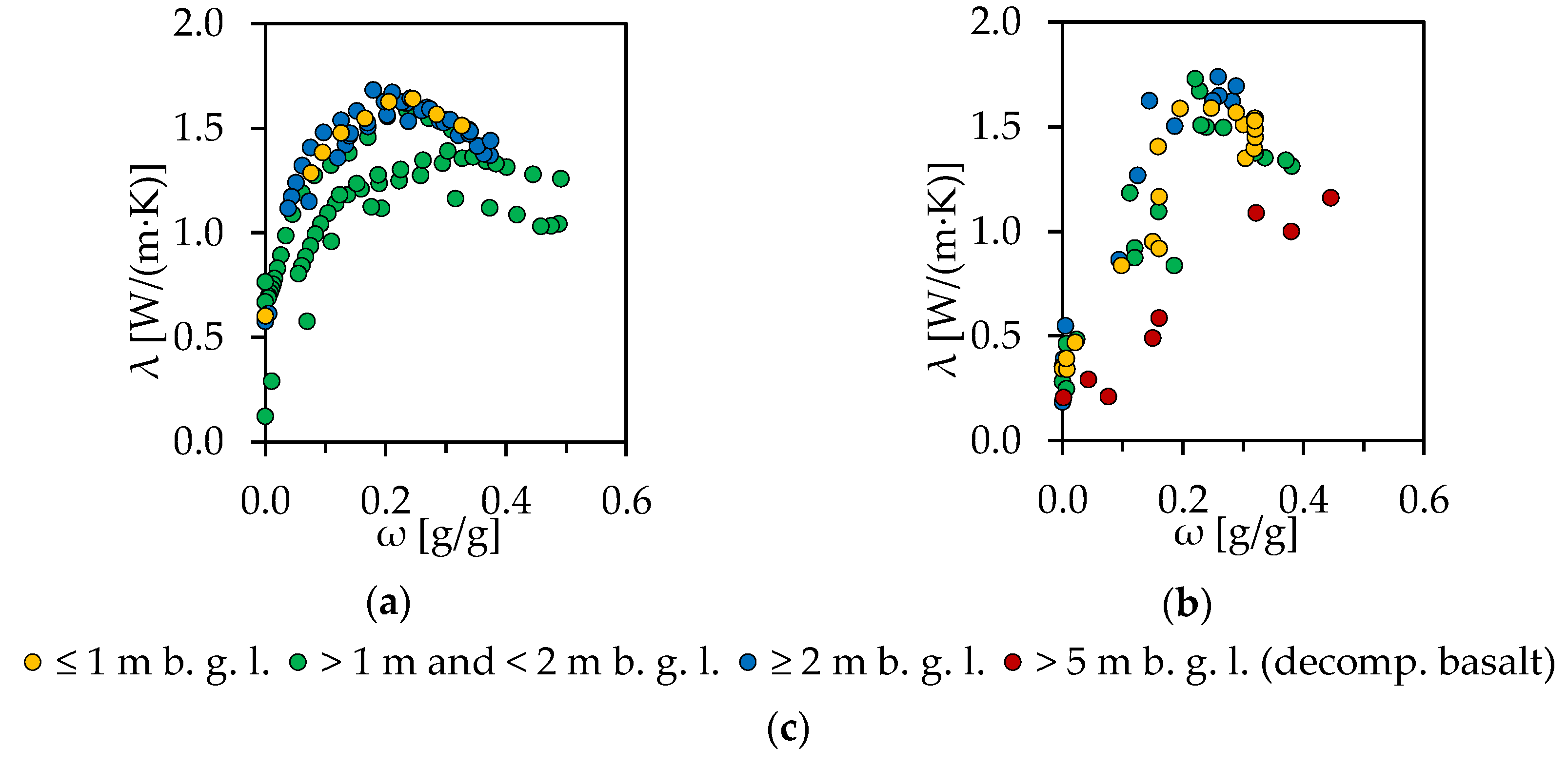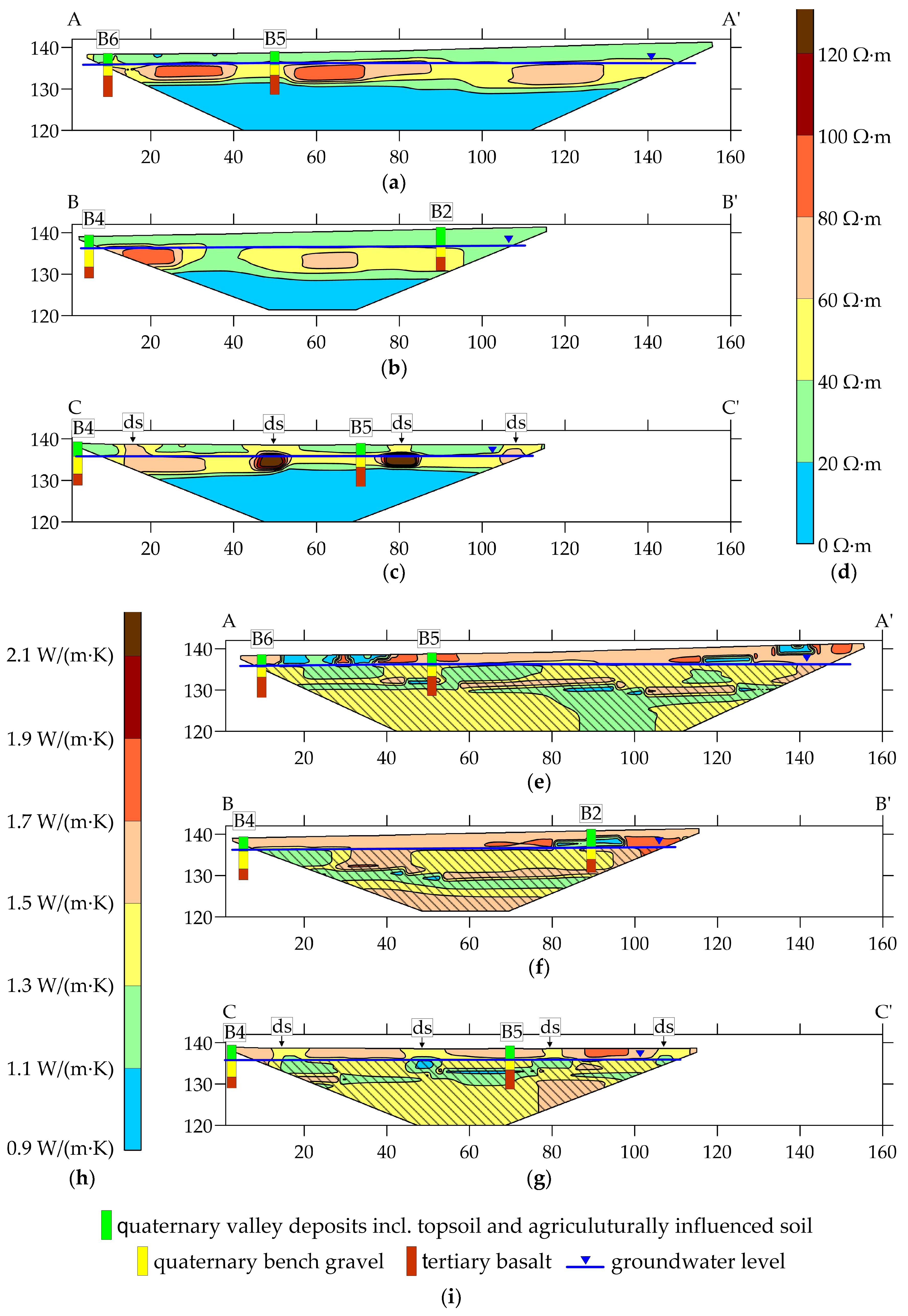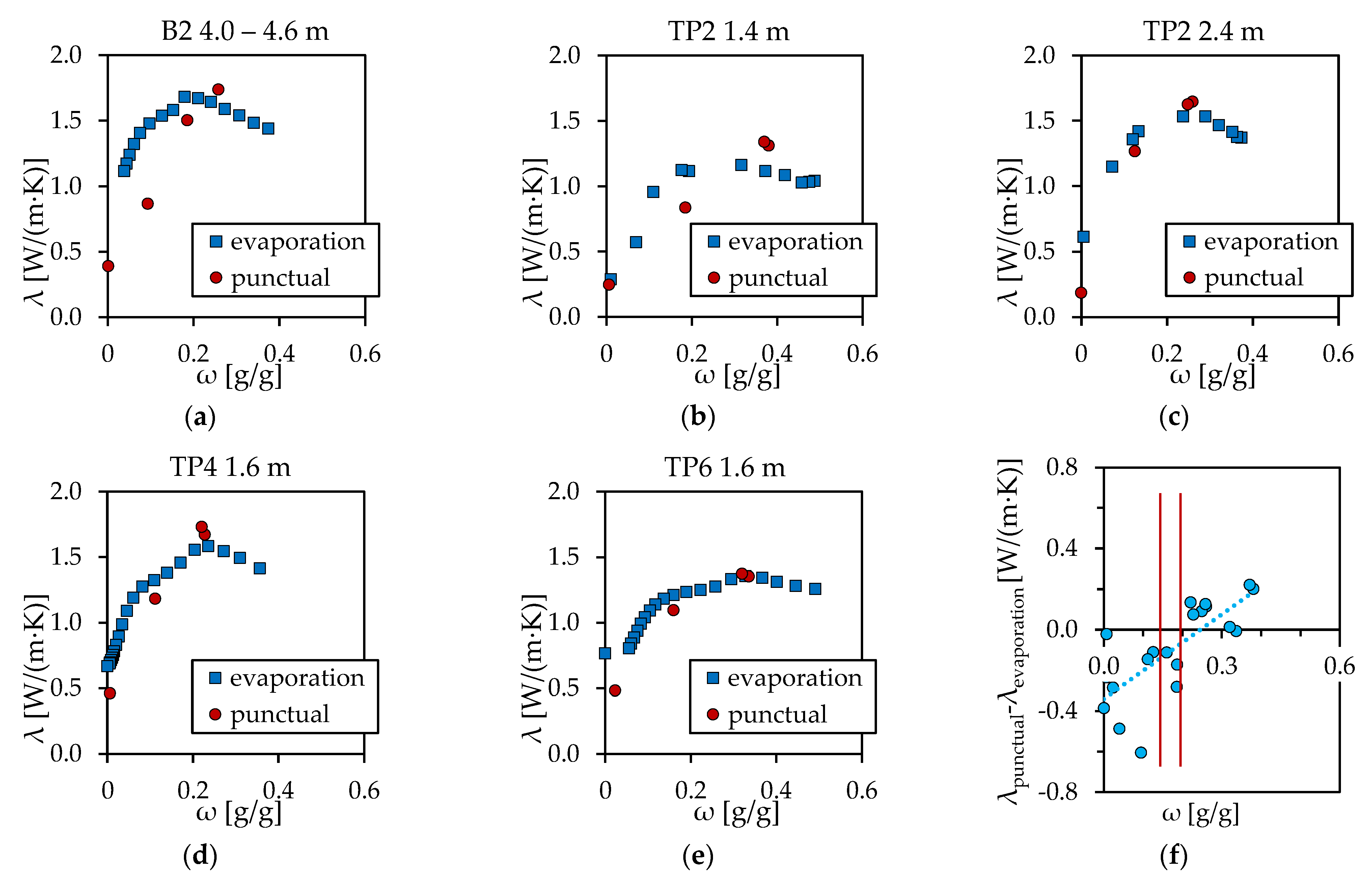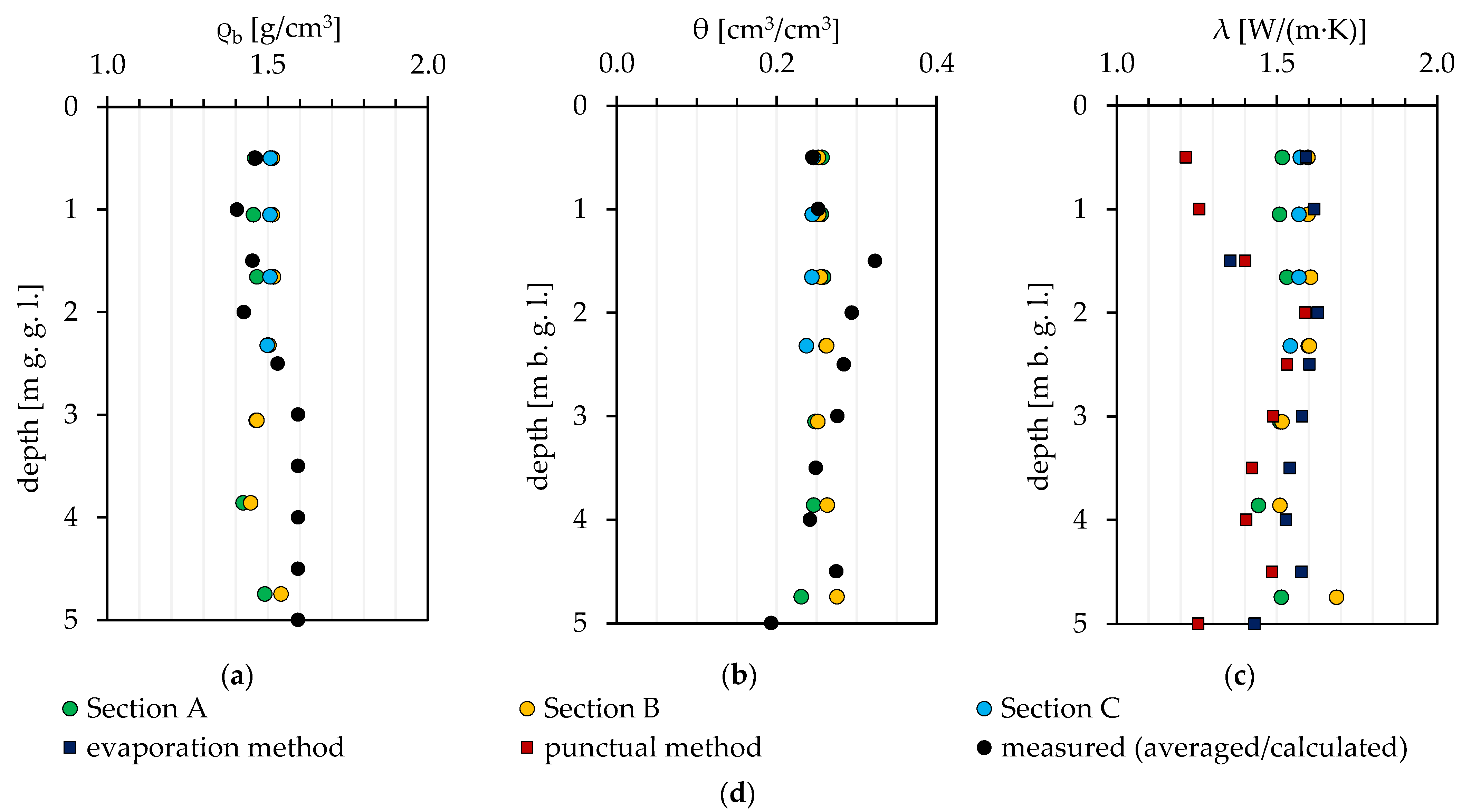Comparison of Measured and Derived Thermal Conductivities in the Unsaturated Soil Zone of a Large-Scale Geothermal Collector System (LSC)
Abstract
1. Introduction
1.1. Large-Scale Geothermal Collector System (LSC) in Bad Nauheim (Germany)
1.2. Determination of Thermal Conductivity of Soils
1.3. Aims of This Study
2. Materials and Methods
2.1. Test Site and Geological Conditions
2.2. Field and Laboratory Investigations
2.2.1. Geotechnical and Soil Scientific Investigations
2.2.2. Thermal Conductivity Measurements on a Laboratory Scale
2.3. Electrical Resistivity Tomography (ERT) and Parameter Derivation
3. Results
3.1. Bulk Density and Water Content
3.2. Atterberg Limits and Plasticity Properties
3.3. Thermal Conductivity Measurements Using Evaporation Method
3.4. Thermal Conductivity Measurements Using Punctual Method
3.5. Depth-Dependent Thermal Conductivities
3.6. ERTs and Parameter Derivation
4. Discussion
4.1. Comparison of Laboratory-Scale Methods for Determination of Thermal Conductivity Using Single-Needle Sensors
4.2. Derivation of Physical and Thermal Soil Parameters from ERTs
5. Conclusions
Author Contributions
Funding
Data Availability Statement
Acknowledgments
Conflicts of Interest
Nomenclature
| Acronyms | |
| CI | Intermediate plastic clay |
| CL | Low plastic clay |
| ERT | Electrical resistivity tomography |
| LSC | Large-scale geothermal collector system |
| Variables | |
| θ | volumetric water content [cm3/cm3] |
| λ | thermal conductivity [W/(m∙K)] |
| ρb | bulk density [g/cm3] |
| ρw | density of water [g/cm3] |
| σ25 | electrical conductivity at a temperature of 25 °C [S/m] |
| σT | electrical conductivity [S/m] at a temperature T |
| ω | gravimetric water content [g/g] |
| ωL | liquid limit [g/g] |
| ωP | plastic limit [g/g] |
| ωS | shrinkage limit [g/g] |
| ER | electrical resistivity [Ω∙m] |
| fT | temperature correction factor [-] |
| IP | plasticity index [-] |
| T | subsurface temperature [°C] |
| XClay | Correction factor for soil type group Clay [-] |
| XSilt | Correction factor for soil type group Silt [-] |
References
- Vienken, T.; Händel, F.; Epting, J.; Dietrich, P.; Liedl, R.; Huggenberger, P. Energiewende braucht Wärmewende—Chancen und Limitierungen der intensiven thermischen Nutzung des oberflächennahen Untergrundes in urbanen Gebieten vor dem Hintergrund der aktuellen Energiedebatte in Deutschland. Grundwasser 2015, 21, 5. [Google Scholar] [CrossRef]
- Zeh, R.; Ohlsen, B.; Philipp, D.; Bertermann, D.; Kotz, T.; Jocic, N.; Stockinger, V. Large-Scale Geothermal Collector Systems for 5th Generation District Heating and Cooling Networks. Sustainability 2021, 13, 6035. [Google Scholar] [CrossRef]
- Boesten, S.; Ivens, W.; Dekker, S.C.; Eijdems, H. 5th generation district heating and cooling systems as a solution for renewable urban thermal energy supply. Adv. Geosci. 2019, 49, 129–136. [Google Scholar] [CrossRef]
- Buffa, S.; Cozzini, M.; D’Antoni, M.; Baratieri, M.; Fedrizzi, R. 5th generation district heating and cooling systems: A review of existing cases in Europe. Renew. Sustain. Energy Rev. 2019, 104, 504–522. [Google Scholar] [CrossRef]
- Di Sipio, E.; Bertermann, D. Factors Influencing the Thermal Efficiency of Horizontal Ground Heat Exchangers. Energies 2017, 10, 1897. [Google Scholar] [CrossRef]
- Di Sipio, E.; Bertermann, D. Thermal properties variations in unconsolidated material for very shallow geothermal application (ITER project). Int. Agrophys. 2018, 32, 149–164. [Google Scholar] [CrossRef]
- Sangi, R.; Müller, D. Dynamic modelling and simulation of a slinky-coil horizontal ground heat exchanger using Modelica. J. Build. Eng. 2018, 16, 159–168. [Google Scholar] [CrossRef]
- Selamat, S.; Miyara, A.; Kariya, K. Analysis of Short Time Period of Operation of Horizontal Ground Heat Exchangers. Resources 2015, 4, 507–523. [Google Scholar] [CrossRef]
- Wu, Y.; Gan, G.; Verhoef, A.; Vidale, P.L.; Gonzalez, R.G. Experimental measurement and numerical simulation of horizontal-coupled slinky ground source heat exchangers. Appl. Therm. Eng. 2010, 30, 2574–2583. [Google Scholar] [CrossRef]
- Arning, E.; Kölling, M.; Schulz, H.D.; Panteleit, B.; Reichling, J. Einfluss oberflächennaher Wärmegewinnung auf geochemische Prozesse im Grundwasserleiter. Grundwasser 2006, 11, 27–39. [Google Scholar] [CrossRef]
- Bonte, M.; van Breukelen, B.M.; Stuyfzand, P.J. Temperature-induced impacts on groundwater quality and arsenic mobility in anoxic aquifer sediments used for both drinking water and shallow geothermal energy production. Water Res. 2013, 47, 5088–5100. [Google Scholar] [CrossRef] [PubMed]
- Brielmann, H.; Griebler, C.; Schmidt, S.I.; Michel, R.; Lueders, T. Effects of thermal energy discharge on shallow groundwater ecosystems. FEMS Microbiol. Ecol. 2009, 68, 273–286. [Google Scholar] [CrossRef] [PubMed]
- Brielmann, H.; Lueders, T.; Schreglmann, K.; Ferraro, F.; Avramov, M.; Hammerl, V.; Blum, P.; Bayer, P.; Griebler, C. Oberflächennahe Geothermie und ihre potenziellen Auswirkungen auf Grundwasserökosysteme. Grundwasser 2011, 16, 77. [Google Scholar] [CrossRef]
- Bertermann, D.; Rammler, M. Suitability of Screened Monitoring Wells for Temperature Measurements Regarding Large-Scale Geothermal Collector Systems. Geosciences 2022, 12, 162. [Google Scholar] [CrossRef]
- Hähnlein, S.; Bayer, P.; Ferguson, G.; Blum, P. Sustainability and policy for the thermal use of shallow geothermal energy. Energy Policy 2013, 59, 914–925. [Google Scholar] [CrossRef]
- Taylor, C.A.; Stefan, H.G. Shallow groundwater temperature response to climate change and urbanization. J. Hydrol. 2009, 375, 601–612. [Google Scholar] [CrossRef]
- Farouki, O.T. Thermal Properties of Soils; Cold Regions Research and Engineering Lab: Hanover, NH, USA, 1981. [Google Scholar]
- Bertermann, D.; Klug, H.; Morper-Busch, L.; Bialas, C. Modelling vSGPs (very shallow geothermal potentials) in selected CSAs (case study areas). Energy 2014, 71, 226–244. [Google Scholar] [CrossRef]
- Abu-Hamdeh, N.H. Thermal Properties of Soils as affected by Density and Water Content. Biosyst. Eng. 2003, 86, 97–102. [Google Scholar] [CrossRef]
- Abu-Hamdeh, N.H.; Reeder, R.C. Soil Thermal Conductivity Effects of Density, Moisture, Salt Concentration, and Organic Matter. Soil Sci. Soc. Am. J. 2000, 64, 1285–1290. [Google Scholar] [CrossRef]
- Côté, J.; Konrad, J.-M. A generalized thermal conductivity model for soils and construction materials. Can. Geotech. J. 2011, 42, 443–458. [Google Scholar] [CrossRef]
- Kersten, M. Thermal Properties of Soils; University of Minnesota: Mineapolis, MN, USA, 1949. [Google Scholar]
- Lu, Y.; Lu, S.; Horton, R.; Ren, T. An Empirical Model for Estimating Soil Thermal Conductivity from Texture, Water Content, and Bulk Density. Soil Sci. Soc. Am. J. 2014, 78, 1859–1868. [Google Scholar] [CrossRef]
- Markert, A.; Bohne, K.; Facklam, M.; Wessolek, G. Pedotransfer Functions of Soil Thermal Conductivity for the Textural Classes Sand, Silt, and Loam. Soil Sci. Soc. Am. J. 2017, 81, 1315–1327. [Google Scholar] [CrossRef]
- Barry-Macaulay, D.; Bouazza, A.; Singh, R.M.; Wang, B.; Ranjith, P.G. Thermal conductivity of soils and rocks from the Melbourne (Australia) region. Eng. Geol. 2013, 164, 131–138. [Google Scholar] [CrossRef]
- Low, J.E.; Loveridge, F.A.; Powrie, W.; Nicholson, D. A comparison of laboratory and in situ methods to determine soil thermal conductivity for energy foundations and other ground heat exchanger applications. Acta Geotech. 2015, 10, 209–218. [Google Scholar] [CrossRef]
- Markert, A.; Peters, A.; Wessolek, G. Analysis of the Evaporation Method to Obtain Soil Thermal Conductivity Data in the Full Moisture Range. Soil Sci. Soc. Am. J. 2016, 80, 275–283. [Google Scholar] [CrossRef]
- Suft, O.; Bertermann, D. One-Year Monitoring of a Ground Heat Exchanger Using the In Situ Thermal Response Test: An Experimental Approach on Climatic Effects. Energies 2022, 15, 9490. [Google Scholar] [CrossRef]
- Zarrella, A.; Emmi, G.; Graci, S.; De Carli, M.; Cultrera, M.; Santa, G.D.; Galgaro, A.; Bertermann, D.; Müller, J.; Pockelé, L.; et al. Thermal Response Testing Results of Different Types of Borehole Heat Exchangers: An Analysis and Comparison of Interpretation Methods. Energies 2017, 10, 801. [Google Scholar] [CrossRef]
- Dimech, A.; Cheng, L.; Chouteau, M.; Chambers, J.; Uhlemann, S.; Wilkinson, P.; Meldrum, P.; Mary, B.; Fabien-Ouellet, G.; Isabelle, A. A Review on Applications of Time-Lapse Electrical Resistivity Tomography Over the Last 30 Years: Perspectives for Mining Waste Monitoring. Surv. Geophys. 2022, 43, 1699–1759. [Google Scholar] [CrossRef]
- Loke, M.H.; Chambers, J.E.; Rucker, D.F.; Kuras, O.; Wilkinson, P.B. Recent developments in the direct-current geoelectrical imaging method. J. Appl. Geophys. 2013, 95, 135–156. [Google Scholar] [CrossRef]
- Loke, M.H.; Rucker, D.F.; Chambers, J.E.; Wilkinson, P.B.; Kuras, O. Electrical Resistivity Surveys and Data Interpretation. In Encyclopedia of Solid Earth Geophysics; Gupta, H.K., Ed.; Springer International Publishing: Cham, Switzerland, 2020; pp. 1–6. [Google Scholar]
- Samouëlian, A.; Cousin, I.; Tabbagh, A.; Bruand, A.; Richard, G. Electrical resistivity survey in soil science: A review. Soil Tillage Res. 2005, 83, 173–193. [Google Scholar] [CrossRef]
- Bertermann, D.; Schwarz, H. Laboratory device to analyse the impact of soil properties on electrical and thermal conductivity. Int. Agrophys. 2017, 31, 157–166. [Google Scholar] [CrossRef]
- Logsdon, S.; Green, T.; Bonta, J.; Seyfried, M.; Evett, S. Comparison of Electrical and Thermal Conductivities for Soils from Five States. Soil Sci. 2010, 175, 573–578. [Google Scholar] [CrossRef]
- Tokoro, T.; Ishikawa, T.; Shirai, S.; Nakamura, T. Estimation methods for thermal conductivity of sandy soil with electrical characteristics. Soils Found. 2016, 56, 927–936. [Google Scholar] [CrossRef]
- Bai, W.; Kong, L.-W.; Guo, A. Effects of physical properties on electrical conductivity of compacted lateritic soil. J. Rock Mech. Geotech. Eng. 2013, 5, 406–411. [Google Scholar] [CrossRef]
- Corwin, D.L.; Lesch, S.M. Apparent soil electrical conductivity measurements in agriculture. Comput. Electron. Agric. 2005, 46, 11–43. [Google Scholar] [CrossRef]
- Ewing, R.P.; Hunt, A.G. Dependence of the Electrical Conductivity on Saturation in Real Porous Media. Vadose Zone J. 2006, 5, 731–741. [Google Scholar] [CrossRef]
- Friedman, S.P. Soil properties influencing apparent electrical conductivity: A review. Comput. Electron. Agric. 2005, 46, 45–70. [Google Scholar] [CrossRef]
- McCutcheon, M.C.; Farahani, H.J.; Stednick, J.D.; Buchleiter, G.W.; Green, T.R. Effect of Soil Water on Apparent Soil Electrical Conductivity and Texture Relationships in a Dryland Field. Biosyst. Eng. 2006, 94, 19–32. [Google Scholar] [CrossRef]
- Schwarz, H.; Bertermann, D. Mediate relation between electrical and thermal conductivity of soil. Geomech. Geophys. Geo-Energy Geo-Resour. 2020, 6, 50. [Google Scholar] [CrossRef]
- Narain Singh, D.; Kuriyan, S.J.; Chakravarthy Manthena, K. A generalised relationship between soil electrical and thermal resistivities. Exp. Therm. Fluid Sci. 2001, 25, 175–181. [Google Scholar] [CrossRef]
- Sreedeep, S.; Reshma, A.C.; Singh, D.N. Generalized relationship for determining soil electrical resistivity from its thermal resistivity. Exp. Therm. Fluid Sci. 2005, 29, 217–226. [Google Scholar] [CrossRef]
- Sun, Q.; Lü, C. Semiempirical correlation between thermal conductivity and electrical resistivity for silt and silty clay soils. Geophysics 2019, 84, MR99–MR105. [Google Scholar] [CrossRef]
- Wang, J.; Zhang, X.; Du, L. A laboratory study of the correlation between the thermal conductivity and electrical resistivity of soil. J. Appl. Geophys. 2017, 145, 12–16. [Google Scholar] [CrossRef]
- Dong, Y.; McCartney, J.S.; Lu, N. Critical Review of Thermal Conductivity Models for Unsaturated Soils. Geotech. Geol. Eng. 2015, 33, 207–221. [Google Scholar] [CrossRef]
- Kümmerle, E. Geologische Karte von Hessen 1:25000 5618 Friedberg; Hessisches Landesamt für Bodenforschung: Wiesbaden, Germany, 1976. [Google Scholar]
- Kümmerle, E. Erläuterungen zur Geologischen Karte von Hessen 1: 25000 Blatt Nr. 5618 Friedberg; Hessisches Landesamt für Bodenforschung: Wiesbaden, Germany, 1976; p. 247. [Google Scholar]
- DIN EN ISO 11272; Soil Quality—Determination of Dry Bulk Density (ISO 11272:2017). German version EN ISO 11272:2017; Beuth Verlag GmbH: Berlin, Germany, 2017.
- DIN EN ISO 17892-1; Geotechnical Investigation and Testing—Laboratory Testing of Soil—Part 1: Determination of Water Content (ISO 17892-1:2014). German Version EN ISO 17892-1:2014; Beuth Verlag GmbH: Berlin, Germany, 2015.
- DIN EN ISO 17892-12; Geotechnical Investigation and Testing—Laboratory Testing of Soil—Part 12: Determination of Liquid and Plastic Limits (ISO 17892-12:2018). German version EN ISO 17892-12:2018; Beuth Verlag GmbH: Berlin, Germany, 2020.
- Krabbe, W. Über die Schrumpfung bindiger Böden. Mitteilungen der Hannoverschen Versuchsanstalt für Grundbau und Wasserbau 1958, 13, 256–342. [Google Scholar]
- IEEE Std 442-1981; IEEE Guide for Soil Thermal Resistivity Measurements. IEEE Power Engineering Society: New York, NY, USA, 1981.
- ASTM D5334; Standard Test Method for Determination of Thermal Conductivity of Soil and Soft Rock by Thermal Needle Probe Procedure. ASTM International: West Conshohocken, PA, USA, 2014.
- Sheets, K.R.; Hendrickx, J.M.H. Noninvasive Soil Water Content Measurement Using Electromagnetic Induction. Water Resour. Res. 1995, 31, 2401–2409. [Google Scholar] [CrossRef]
- Bertermann, D.; Schwarz, H. Bulk density and water content-dependent electrical resistivity analyses of different soil classes on a laboratory scale. Environ. Earth Sci. 2018, 77, 570. [Google Scholar] [CrossRef]
- Boivin, P.; Garnier, P.; Tessier, D. Relationship between Clay Content, Clay Type, and Shrinkage Properties of Soil Samples. Soil Sci. Soc. Am. J. 2004, 68, 1145–1153. [Google Scholar] [CrossRef]
- Haines, W.B. The volume-changes associated with variations of water content in soil. J. Agric. Sci. 1923, 13, 296–310. [Google Scholar] [CrossRef]
- Smith, C.W.; Hadas, A.; Dan, J.; Koyumdjisky, H. Shrinkage and Atterberg limits in relation to other properties of principal soil types in Israel. Geoderma 1985, 35, 47–65. [Google Scholar] [CrossRef]
- Sharanya, A.G.; Mudavath, H.; Thyagaraj, T. Review of methods for predicting soil volume change induced by shrinkage. Innov. Infrastruct. Solut. 2021, 6, 116. [Google Scholar] [CrossRef]
- Ardiansyah; Shiozawa, S.; Nishida, K. Thermal properties and shrinkage-swelling characteristic of clay soil in a tropical paddy field. J. Jpn. Soc. Soil Phys. 2008, 110, 67–77. [Google Scholar]
- Brake, B.; Ploeg, M.; de Rooij, G. Water storage change estimation from in situ shrinkage measurements of clay soils. Hydrol. Earth Syst. Sci. 2013, 17, 1933–1949. [Google Scholar] [CrossRef]
- Schäffer, B.; Schulin, R.; Boivin, P. Shrinkage Properties of Repacked Soil at Different States of Uniaxial Compression. Soil Sci. Soc. Am. J. 2013, 77, 1930–1943. [Google Scholar] [CrossRef]
- Knödel, K.; Krummel, H.; Lange, G. Handbuch zur Erkundung des Untergrundes von Deponien und Altlasten Band 3: Geophysik; Springer: Berlin, Germany, 2005; p. 1102. [Google Scholar]
- Zohdy, A.A.R.; Jackson, D.B. Application of deep electrical soundings for groundwater exploration in Hawaii. Geophysics 1969, 34, 584–600. [Google Scholar] [CrossRef]
- Schäffer, R.; Sass, I. Ausbreitung und Vermischung geogener, kohlendioxidführender Thermalsole in oberflächennahem Grundwasser, Bad Nauheim. Grundwasser 2016, 21, 305–319. [Google Scholar] [CrossRef]









| Parameter | Number of Tests | Method |
|---|---|---|
| dry bulk density (ρb) | 36 | undisturbed sampling with stabbing cylinders and oven drying based on DIN EN ISO 11272 [50] |
| gravimetric water content (ω) | 57 | sampling and oven drying based on DIN EN ISO 17892-1 [51] |
| Atterberg limits and plasticity index | 5 | plastic limit (ωP), liquid limit (ωL) and plasticity index (IP) according to DIN EN ISO 17892-12 [52] and shrinkage limit (ωS) according to Krabbe [53] |
| Method | Thermal Properties Analyzer | Single-Needle | Accuracy | Measuring Interval | Preparation/Experimental Procedure |
|---|---|---|---|---|---|
| Evaporation | KD2 Pro Tempos | TR-1 (10 cm); TR-3 (10 cm) | ±10% from 0.2–4.0 W/(m∙K); ±10% from 0.1–4.0 W/(m∙K) | 15 min-days |
|
| Punctual | Tempos | TR-3 (10 cm) | ±10% from 0.1–4.0 W/(m∙K) | - |
|
| Sampling Point | Depth [m b. g. l.] | Stratigraphic Unit | USDA | Evaporation Method | Punctual Method | ρb_ini [g/cm3] |
|---|---|---|---|---|---|---|
| B2 | 4.0–4.6 | Quaternary valley deposits | Silty clay loam | ✓ | ✓ | 1.48; 1.45; 1.46 |
| B4 | 8.0–9.0 | Tertiary basalt (Rotlehm) | Clay | ✕ | ✓ | 1.27; 1.38 |
| B5 | 6.2–6.9 | Tertiary basalt (decomposed) | Silt loam | ✕ | ✓ | 1.43; 1.46 |
| TP1 | 0.2 | Topsoil | Silt loam | ✓ | ✕ | 1.57 |
| 1.4–1.9 | Quaternary valley deposits | Silty clay loam | ✓ | ✕ | 1.39 | |
| 2.4 | Quaternary valley deposits | Silt loam | ✓ | ✕ | 1.47 | |
| 2.9–3.4 | Quaternary valley deposits | Silt loam | ✓ | ✕ | 1.50 | |
| TP2 | 0.2 | Topsoil | Silty clay loam | ✕ | ✓ | 1.22; 1.24 |
| 0.7 | Agriculturally influenced soil | - | ✕ | ✓ | 1.15 | |
| 1.4 | Quaternary valley deposits | Silt loam | ✓ | ✓ | 1.16; 1.15 | |
| 1.9 | Quaternary valley deposits | - | ✕ | ✓ | 1.36 | |
| 2.4 | Quaternary valley deposits | - | ✓ | ✓ | 1.50; 1.47; 1.49 | |
| 2.9 | Quaternary valley deposits | Silt loam | ✕ | ✓ | 1.55; 1.56 | |
| TP4 | 0.6 | Anthropogenic filling | Silty clay | ✕ | ✓ | 1.41; 1.49 |
| 1.2 | Quaternary valley deposits | Silty clay loam | ✕ | ✓ | 1.47; 1.55 | |
| 1.6 | Quaternary valley deposits | Silt loam | ✓ | ✓ | 1.51; 1.50 | |
| TP6 | 0.6 | Anthropogenic filling | Loam | ✕ | ✓ | 1.28; 1.29 |
| 0.6 | Anthropogenic filling | Loam | ✕ | ✓ | 1.28; 1.29 | |
| 1.6 | Quaternary valley deposits | Silty clay loam | ✓ | ✓ | 1.30; 1.28 |
| Section | Method | Maximal Measurement per Point | Threshold Measurement Error [%] | Electrode Spacing [m] | Length [m] | Measured Layers | Measured Depth [m b. g. l.] |
|---|---|---|---|---|---|---|---|
| A | Wenner array [31] | 40 | 0.1 | 2 | 158 | 20 | 28 |
| B | 25 | 0.2 | 2 | 118 | 17 | 20 | |
| C | 25 | 0.2 | 2 | 118 | 17 | 20 |
| Depth [m b. g. l.] | ω [g/g] | ρb [g/cm3] | θ [cm3/cm3] |
|---|---|---|---|
| 0.5 | 0.17 (0.06/24) | 1.46 (0.16/19) | 0.24 |
| 1.0 | 0.18 (0.06/23) | 1.40 (0.15/12) | 0.25 |
| 1.5 | 0.22 (0.04/16) | 1.45 (0.16/11) | 0.32 |
| 2.0 | 0.21 (0.05/17) | 1.43 (0.09/8) | 0.29 |
| 2.5 | 0.19 (0.04/8) | 1.53 (0.10/5) | 0.28 |
| 3.0 | 0.17 (0.05/11) | 1.59 (0.07/3) | 0.28 |
| 3.5 | 0.16 (0.05/6) | 1.59 (0.00/1) | 0.25 |
| 4.0 | 0.15 (0.04/7) | 1.59 (-/-) | 0.24 |
| 4.5 | 0.17 (0.04/3) | 1.59 (-/-) | 0.27 |
| 5.0 | 0.12 (0.05/3) | 1.59 (-/-) | 0.19 |
| Sample Point | Depth [m b. g. l.] | ωL [g/g] | ωP [g/g] | IP | ωS [g/g] | PC |
|---|---|---|---|---|---|---|
| B2 | 2.7–4.6 | 0.29 | 0.19 | 0.10 | 0.17 | CL |
| TP1 | 1.4–1.9 | 0.40 | 0.19 | 0.21 | 0.14 | CI |
| TP1 | 2.9–3.4 | 0.29 | 0.21 | 0.08 | 0.19 | CL |
| TP2 | 2.9 | 0.29 | 0.20 | 0.08 | 0.18 | CL |
| TP4 | 1.6 | 0.28 | 0.21 | 0.08 | 0.19 | CL |
| Sample Point | Depth [m b. g. l.] | ρb_ini [g/cm3] | ρb_sat [g/cm3] | ρb_dry [g/cm3] | Clay Content |
|---|---|---|---|---|---|
| TP2 | 1.4 | 1.16 | ~1.2 | ~1.5 | 26% |
| TP2 | 2.4 | 1.50 | ~1.3 | ~1.6 | 24% 1 |
| TP4 | 1.6 | 1.51 | ~1.4 | ~1.7 | 23% |
| TP6 | 1.6 | 1.30 | ~1.2 | ~1.6 | 35% |
| B2 | 4.0–4.6 | 1.48 | ~1.3 | ~1.8 | 35% |
| Depth [m b. g. l.] | λevaporation [W/(m∙K)] | R2evaporation/RMSE | λpunctual [W/(m∙K)] | R2punctual/RMSE |
|---|---|---|---|---|
| 0.5 | 1.6 | 0.98/0.04 | 1.2 | 0.93/0.13 |
| 1.0 | 1.6 | 1.3 | ||
| 1.5 | 1.4 | 0.73/0.16 | 1.4 | 0.87/0.17 |
| 2.0 | 1.6 | 0.90/0.09 | 1.6 | 0.95/0.12 |
| 2.5 | 1.6 | 1.5 | ||
| 3.0 | 1.6 | 1.5 | ||
| 3.5 | 1.5 | 1.4 | ||
| 4.0 | 1.5 | 1.4 | ||
| 4.5 | 1.6 | 1.5 | ||
| 5.0 | 1.4 | 1.3 |
| Depth [m b. g. l.] | ρb [g/cm3] | θ [cm3/cm3] | λ [W/(m∙K)] | ||||||
|---|---|---|---|---|---|---|---|---|---|
| A | B | C | A | B | C | A | B | C | |
| 0.5 | 1.46 (0.13) | 1.51 (0.01) | 1.51 (0.03) | 0.26 (0.02) | 0.25 (0.01) | 0.25 (0.03) | 1.5 (0.2) | 1.6 (0.0) | 1.6 (0.1) |
| 1.1 | 1.45 (0.13) | 1.51 (0.01) | 1.51 (0.03) | 0.26 (0.02) | 0.25 (0.01) | 0.24 (0.03) | 1.5 (0.3) | 1.6 (0.0) | 1.6 (0.1) |
| 1.7 | 1.47 (0.13) | 1.52 (0.01) | 1.51 (0.03) | 0.26 (0.02) | 0.25 (0.01) | 0.24 (0.03) | 1.5 (0.2) | 1.6 (0.0) | 1.6 (0.1) |
| 2.3 | 1.50 (0.09) | 1.50 (0.09) | 1.50 (0.03) | 0.26 (0.02) | 0.26 (0.02) | 0.24 (0.03) | 1.6 (0.2) | 1.6 (0.2) | 1.5 (0.1) |
| 3.1 | 1.46 (0.12) | 1.47 (0.12) | - | 0.25 (0.04) | 0.25 (0.03) | - | 1.5 (0.3) | 1.5 (0.2) | - |
| 3.9 | 1.42 (0.15) | 1.45 (0.15) | - | 0.25 (0.03) | 0.26 (0.02) | - | 1.4 (0.3) | 1.5 (0.3) | - |
| 4.7 | 1.49 (0.00) | 1.54 (0.01) | - | 0.23 (0.00) | 0.28 (0.01) | - | 1.5 (0.0) | 1.7 (0.0) | - |
| Parameter | Minimum Deviation | Maximal Deviation | Average Deviation | ||||||
|---|---|---|---|---|---|---|---|---|---|
| A | B | C | A | B | C | A | B | C | |
| ρb [g/cm3] | −0.1 | −0.1 | −0.1 | 0.2 | 0.1 | 0.0 | 0.1 | 0.0 | −0.1 |
| θ [cm3/cm3] | −0.01 | −0.02 | 0.00 | 0.07 | 0.07 | 0.08 | 0.02 | 0.01 | 0.03 |
| λpunctual [W/(m∙K)] | −0.3 | −0.4 | −0.4 | 0.0 | 0.0 | 0.0 | −0.1 | −0.2 | −0.2 |
| λevaporation [W/(m∙K)] | −0.2 | −0.2 | −0.2 | 0.1 | 0.1 | 0.1 | 0.0 | 0.0 | 0.0 |
Disclaimer/Publisher’s Note: The statements, opinions and data contained in all publications are solely those of the individual author(s) and contributor(s) and not of MDPI and/or the editor(s). MDPI and/or the editor(s) disclaim responsibility for any injury to people or property resulting from any ideas, methods, instructions or products referred to in the content. |
© 2023 by the authors. Licensee MDPI, Basel, Switzerland. This article is an open access article distributed under the terms and conditions of the Creative Commons Attribution (CC BY) license (https://creativecommons.org/licenses/by/4.0/).
Share and Cite
Rammler, M.; Schwarz, H.; Wagner, J.; Bertermann, D. Comparison of Measured and Derived Thermal Conductivities in the Unsaturated Soil Zone of a Large-Scale Geothermal Collector System (LSC). Energies 2023, 16, 1195. https://doi.org/10.3390/en16031195
Rammler M, Schwarz H, Wagner J, Bertermann D. Comparison of Measured and Derived Thermal Conductivities in the Unsaturated Soil Zone of a Large-Scale Geothermal Collector System (LSC). Energies. 2023; 16(3):1195. https://doi.org/10.3390/en16031195
Chicago/Turabian StyleRammler, Mario, Hans Schwarz, Jan Wagner, and David Bertermann. 2023. "Comparison of Measured and Derived Thermal Conductivities in the Unsaturated Soil Zone of a Large-Scale Geothermal Collector System (LSC)" Energies 16, no. 3: 1195. https://doi.org/10.3390/en16031195
APA StyleRammler, M., Schwarz, H., Wagner, J., & Bertermann, D. (2023). Comparison of Measured and Derived Thermal Conductivities in the Unsaturated Soil Zone of a Large-Scale Geothermal Collector System (LSC). Energies, 16(3), 1195. https://doi.org/10.3390/en16031195








